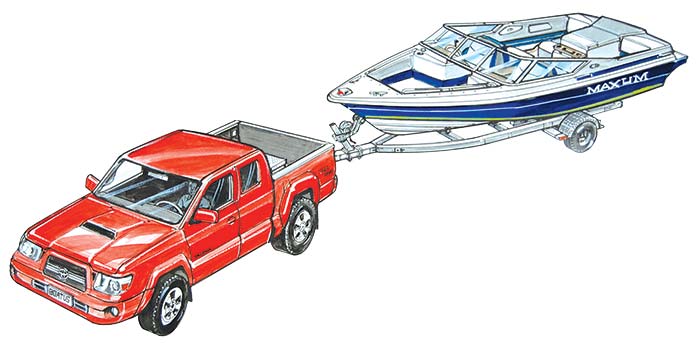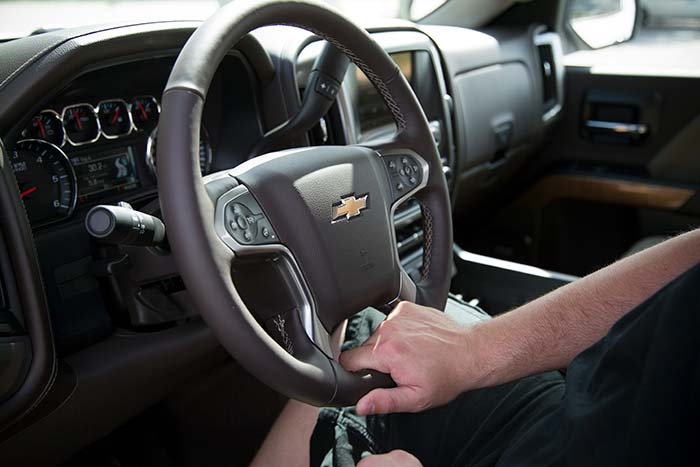Advertisement
It requires teaching your brain some new habits, but practice is the key to success.

Illustration: Dick Everitt/ dickeveritt.com
Directing a boat trailer to a specific spot at a specific angle on an articulated hinge, while driving in reverse, is not a natural act — despite what you may see at the launch ramp. But with a few basic lessons, a handful of helpful tips, and some practice, you can learn to back up a trailer like a pro. In this article, we'll walk you through the process step by step.
Tip
Set Up For Success
Situations in which you may be required to back your boat trailer can include anything from a simple straight line to negotiating around a tight corner or slipping it between or around obstacles. For practice purposes, we recommend creating a low-stress setting using cones in an empty parking lot or other open area, with plenty of room to maneuver and nothing to hit if you make a mistake.
Once you get a few practice sessions under your seatbelt, begin to negotiate more complicated situations until you become comfortable with your skills.
Preparation Is Key
Before you go anywhere, make sure your side mirrors are properly adjusted. You'll know they're set correctly from the driver's seat when you can see the side of the trailer on the inner third or half of the corresponding mirror. The outer half of the mirror will show any approaching hazards. If you don't feel like you can see enough of, or around, your trailer, add wide-angle or blind-spot mirror attachments.
Now, turn on your hazard lights as an alert to other drivers, and let's get started.
The Physics Of Backing
Understanding how your boat trailer reacts when you steer your tow vehicle is crucial to successful backing in any situation. The key is remembering that when you have a trailer in tow, the back of the trailer will move in the opposite direction to that of your vehicle.
So, for example, if you shift your vehicle into reverse, turn your steering wheel clockwise, and put your foot on the gas, the back of your vehicle will go to the right as usual, but the back of the trailer will go left. In other words, if your hands are on the wheel at the 9-and-3 position, you must turn the steering wheel in the opposite direction that you want your trailer to go.
A no-fail tip is to grasp the wheel (palm down) with one hand at 6 o'clock (bottom of the wheel). From this position, if you want the trailer to go left, move your hand to the left (clockwise). If you want the trailer to go right, move your hand right (counterclockwise). Much easier!
A well-executed backing is something to be proud of, your moment to be a hero. The way to make that routine is through practice. Try backing up in multiple settings and from multiple angles to teach your brain and body how to navigate this essential part of trailer boating.
Backing Basics
You're parked in a safe setting, have your mirrors set, and understand the theory of how this should work, so let's put it into practice. One final piece of advice: This is not a high-speed maneuver. Slow and steady is the rule, just like when you're steering your boat to the dock.
1. Pull the boat trailer up so there's plenty of room on all sides of both your vehicle and the boat, your wheels are straight, and the vehicle and trailer are in alignment.
2. Check both side mirrors for any obstructions around the truck and trailer.

Photo: Billy Black
3. After you shift into reverse, grip the wheel with one hand at 6 o'clock and gently put your foot on the gas. By keeping the vehicle's wheels straight, the trailer should move more or less in a straight line. Watch the trailer and vehicle as well as your surroundings by alternating your glance between both side mirrors.
4. If the trailer begins to drift, move your hand in the opposite direction to correct it. (The amount your turn the wheel depends on the correction that's needed, so turn the wheel slowly, a little at a time.) As soon as the trailer responds, bring the wheels back to center and slowly continue backing in a straight line, making small corrections as needed.
Backing Through A Turn
Now let's increase the difficulty by practicing backing your trailer through a turn. The principles are the same as backing in a straight line; it just takes patience, concentration, and a bit of practice.
1. Set up some cones to simulate the entrance to a driveway or launch ramp that requires you to back the trailer in a 90-degree turn to the right.
2. Just as you did in the basic exercise above, pull your trailer up so you have enough room to maneuver it, straighten the wheels, and ensure that the vehicle and trailer are in alignment. The amount of space needed to get the trailer between the cones depends on many factors, including the length of the vehicle and trailer and the location of curbs and other obstacles. Give yourself plenty of room to maneuver.
3. Grasp the wheel at 6 o'clock, shift the vehicle into reverse, look around for any obstacles, and then keep your eye on the right side mirror. Gently put your foot on the gas, then move your hand on the steering wheel to the right (counterclockwise) to move the trailer to the right. You'll see the trailer turning to the right in the mirror.
4. Once the trailer begins to arc through the turn, bring the vehicle's wheels back to center while still keeping your foot gently on the gas. This should start to bring the vehicle around to follow the direction of the trailer while the trailer continues to move backward in an arc.
5. Progressing through the turn, occasionally check the front and back of the vehicle and also glance at the left side mirror a couple of times. Front tires turned hard to one side can run right into, or over, a deflating situation. While you probably won't run into anything today in this big, empty lot, get used to doing it for when there are obstacles nearby.
6. Once the trailer and vehicle are in alignment, continue to back up in a straight line until the trailer is between the cones. Note: If you oversteer and the trailer passes a 90-degree angle before you get it between the cones, stop, shift into drive, straighten out by driving forward, then start the backing process again. There's no shame in multiple attempts, and in some tight situations, multiple switches from reverse to forward and back again may be required.
